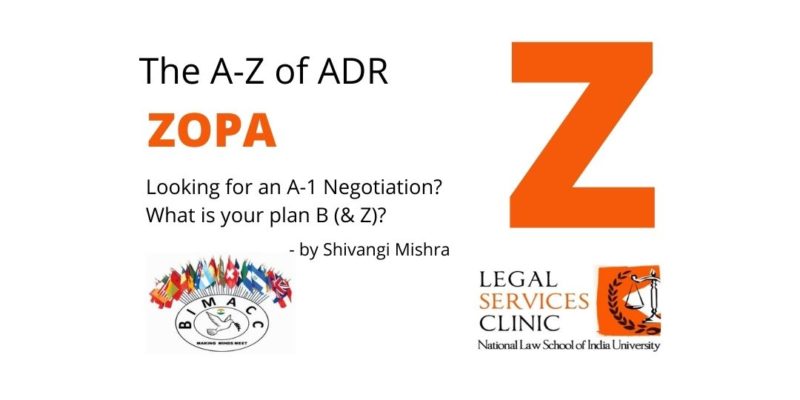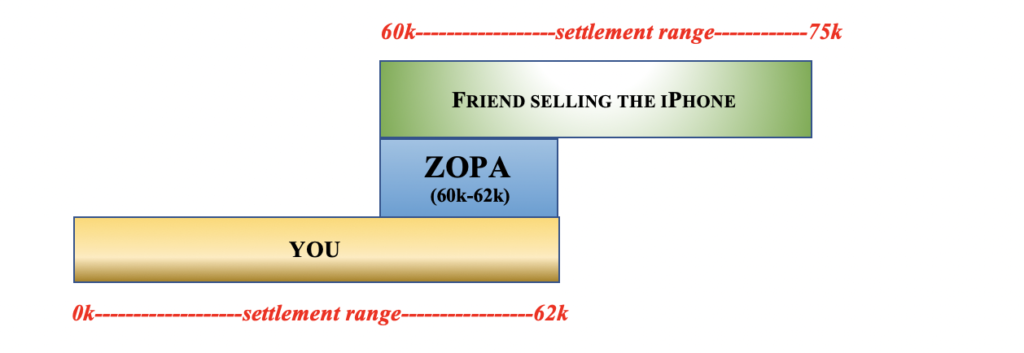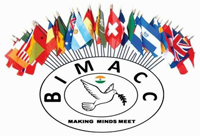
A-Z of ADR: ZOPA – Looking for an A-1 Negotiation? What is your Plan B (& Z)?
-Shivangi Mishra (IIIrd Year, NLSIU Bangalore)
Introduction
In the A to Zs of Alternative methods of Dispute Resolution, the Bs and Zs are often referred to in every negotiation that takes place – The BATNA and the ZOPA. You may be averse to terminologies (after all, negotiations are supposed to be simple, right?), but knowing the Bs and Zs, is your key to a good negotiation. Here’s a brief explainer on how to master your Bs and Zs for an A-1 negotiation!
Best Alternative to a Negotiated Agreement (BATNA)
Why know your BATNA ?
Negotiating over interests and options is instrumental but in vain, if the other party has a greater bargaining power. In such a scenario, it is important that you don’t make an agreement that you should be rejecting. Further, the agreement you come to must coincide with your interests to the greatest extent possible. To avoid hastily submitting to a party with a stronger position, what is that you need? While you may set a bottom line for yourself as the worst acceptable outcome, it inhibits you from being flexible to exploring options in the negotiation. Knowing your BATNA, at this moment, serves as the placebo to an otherwise tensed negotiating environment. Your BATNA should be the standard against which you measure the proposed agreement.
What happens when you have a BATNA?
All of us have a fallback option in life because we are insecure of our goals at one point or the other. What if we don’t succeed? What is plan B? In a negotiation, it is the BATNA.
Thinking through the whole plan is representative of a good negotiator but knowing what you are going to do if the negotiation doesn’t lead to an agreement is the symbol of an excellent negotiator. It not only inspires confidence in you to assert your needs but also adds to certainty to the whole process. The greater your willingness to break off the negotiations, the more forcefully you can present your interests and the basis on which you believe an agreement should be reached.[1]
Having said that, it is equally important to understand the BATNA of the other party. The more you know of their alternatives, the better you are prepared for what to realistically expect from the negotiation.
Zone of Possible Agreement (ZOPA)
The ZOPA is often referred to as the bargaining range. In the event that the alternative options are not as attractive, the parties should analyze if there exists a potential agreement that could benefit both sides.[2] While the ZOPA is critical to the negotiation, it is not easy to discover. Discovering a ZOPA increases your chances at coming to an agreement but the question is how do you make this discovery?
Discovering the ZOPA
This is where your interest-based negotiations prove themselves as a success. Exploring the interests and options of the other party and measuring it against yours will lead you to find a common ground. This common ground is not the exact deal but a range of options which are amenable to both the parties. An agreement within this range is likely to be the outcome of a well-negotiated deal.
Look at the following example to understand what this haunted Zz-ZOPA is!
For instance: You want to buy a secondhand iPhone 11 from a friend. Your parents have allowed you to spend up to 70k on the same, but you also want to buy AirPods worth 8k. Your friend bought it for 75k but since it’s second-hand, she is willing to sell it for minimum 60k.

Well, that was pretty
simple, wasn’t it?
Conclusion
The Bs and Zs shouldn’t (hopefully) haunt you anymore! Negotiations, in fact, could be complex but they aren’t supposed to be a troublesome experience. An understanding of the above two concepts is crucial and with proper preparation, you can create the maximum value in the agreements you reach.[3]
[1] Roger Fisher and William Ury. Getting to Yes: Negotiating Agreement Without Giving In, 3rd ed. (New York: Penguin Books, 2011).
[2] Spangler, Brad. “Zone of Possible Agreement (ZOPA).” Beyond Intractability. Eds. Guy Burgess and Heidi Burgess. Conflict Information Consortium, University of Colorado, Boulder. Posted: June 2003 <http://www.beyondintractability.org/essay/zopa>.
[3]Marcela Merino, Understanding ZOPA: The Zone of Possible Agreement, Business Insights: Harvard Business School Online available at https://online.hbs.edu/blog/post/understanding-zopa (Last visited on July 31, 2020).
-Shivangi Mishra (IIIrd Year, NLSIU Bangalore)
Ms Shivangi Mishra is a Third Year Law Student at the National Law School of India University (NLSIU), Bangalore.
BIMACC expresses its gratitude towards the author and to the members of the Legal Services Clinic, National Law School of India University (NLSIU) for their support in our collaborative efforts to promote ADR with this series titled “A-Z of ADR”. The purpose of this series is to increase the understanding of certain fundamental concepts of Alternative Dispute Resolution.
The Legal Services Clinic is a student-run committee that provides free legal services to the socially and the economically backward sections of the society who have difficulty accessing the judicial system. It also has a mandate of spreading legal awareness and providing free legal assistance to those who cannot afford it.
Website: www.legalservicesclinic.org/
Facebook: @legalservicesclinic
Email: lsc.nlsiu@gmail.com
Phone Number: 073586 73214
Disclaimer: The views and opinions expressed in this blog are those of the authors and do not necessarily reflect the official policy or position of BIMACC, any of the members of the Board, or the empanelled neutrals.
